Most recently, architects and designers, with the help of CAPS professionals, have been concentrating on revising home interior design basics. The obvious outcome is slowly we are creating design principles and strategies that accommodate the full range of human capability rather than only the fully-functional part of society. This field of flexible or inclusive design is called Universal Design and its goal is to create easily accessible living and working spaces without exclusion to anyone. Instead of appearing as a hospital extension, the thoughtful new designs are appealing, stylish and comfortable for everyone; not just the elder or severely disabled among us. Therefore, the world of boundaries and barricades is beginning to lessen while we overcome the nationwide problem one home at a time. This is a testament to the senior and disabled population demanding equal access to their homes.
The ADA rules came about in 1990, but unfortunately the ADA rules do not apply to the private residential market. However, these rules can be used as a guide for better accessibility in private homes. Seniors and disabled homeowners must depend on the knowledgeable CAPS certified private sector of builders and remodelers to remedy the housing shortcomings. They will supply the recommended aging in place home modifications. Universally, every home should be accessible to all inhabitants and their visitors regardless of their age, size, or physical abilities. Caring for someone with special needs is a unique and sometimes lifelong challenge. Whether it’s a child born with a disability, someone who has suffered an unfortunate accident or medical event causing them to lose abilities they once had, or an older family member in declining health needing assistance with daily life, the work of a special needs contractor can help make things easier for both the affected individual and their caregivers.
Accessible Bathroom Modifications In Austin
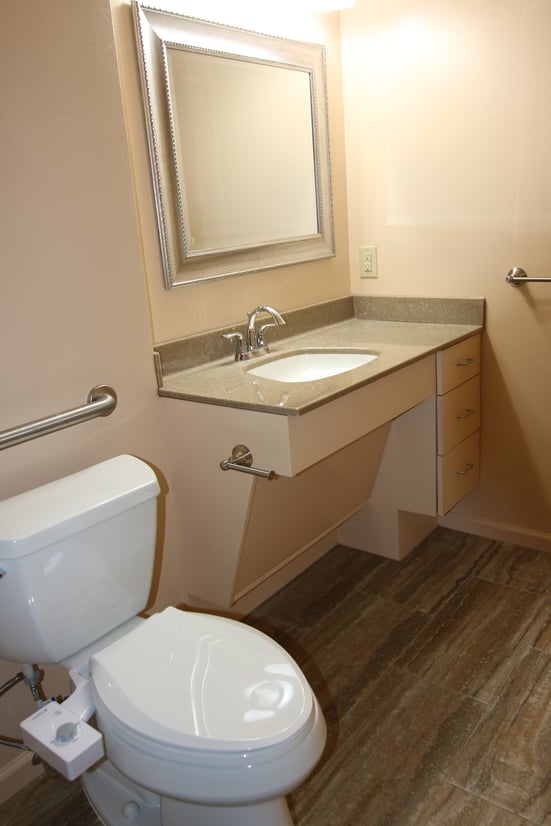
What are the most important home modifications for seniors and the disabled to increase their quality of life? Here is a list of considerations for Aging in Place.
- Replacing door knobs with lever devices.
- Widening doorways and hallways.
- Increasing lighting, especially around stairs and work areas.
- Installing curb-less showers.
- Installing grab bars, especially in wet areas.
- Installing taller comfort-height toilets.
- Installing ramps to overcome level changes.
- Installing lever-controlled faucets.
- Installing hand-held shower devices.
- Adding a shower bench.
- Replacing flooring with any non-skid type.
- Utilizing smart home devices like electric door openers and remote light switches.
- Undergoing kitchen modifications to increase comfort and safety.
- Making bathroom modifications to increase safety and usability.
- Installing a stair lift or vertical platform lift.
T- Square Company located at 14141 Highway 290 West, Suite 800 in Austin, Texas is an industry leading accessible, universal, certified Aging in Place and VA approved Specially Adapted Housing home builder and remodeler. T-Square offers design/build projects for both totally accessible homes from the ground up or complete handicap modifications for existing homes to Age in Place. Be aware, traditional home builders and remodelers do not consider or understand the needs of the disabled or elderly. They deal mainly with the two thirds of our society without disabilities or special needs. They do not have the knowledge or experience required to think out of the box when creating a special needs home. It requires a trained and educated accessible home builder or contractor to visualize special needs modifications for special people.

T-Square Company will design and build you an adapted living environment which is completely customized around your abilities. Whether your project concerns home modifications, an accessible addition or wing, or new construction derived from a handicap accessible floor plan they can help you increase your accessibility. David Traut, the president/owner, is CAPS certified (1636580) and has over three decades of building and remodeling experience practicing as a disability contractor for special needs. He wants to help his clients be as self sufficient and independent as possible. Let David show you how to increase the safety and accessibility within your personal living environment.
By the way, David has recently published a book entitled "Age in Place at Home: Adapting the Home Environment for All Generations". It is available on Amazon and stands as a reference book for increasing home accessibility through Universal Design.

Contact T-Square Company today at 512-444-0097 so we can show you how to begin a new accessible chapter in your lifetime.
Tags:
aging in place home modifications,
accessibility home remodeling in Austin,
aging in place specialist,
aging in place services,
Austin Senior Home Remodeling,
handicap accessible bathroom remodeling,
Austin aging in place specialist,
handicap bathroom remodel,
accessible home remodeling for disabilities,
barrier free showers in Austin,
ADA compliant roll in showers,
handicap ADA roll in shower,
wheelchair accessible shower stalls,
accessible bathroom design specifications,
home remodeling contractors residential,
disabled bathroom remodel,
specialty construction in Austin,
what is an ADA compliant bathroom,
home access in Austin,
home accessibility,
wheelchair accessible housing,
accessible homes in austin,
accessible home modifications,
wheelchair accessible bathroom,
handicap bathroom design,
handicap bathroom vanity,
handicap bathroom contractor in Austin,
handicap accessible floor plans,
accessible home builder in Austin,
special needs contractor,
universal home design in Austin,
home renovations for disability in Austin,
ADA Accessibility,
ADA Contractor/Austin, Texas,
Barrier-free designs
The present out of control housing market situation prompted a search for answers solving the question of how to create houses capable of meeting the needs of tomorrow while accommodating future life changes. There is no one size fits all home design because everyone’s life experience is unique to them creating a diverse society with diverse physical needs. Using Universal Design, the wide ranging abilities of the homeowner is a major consideration for all successful inclusive and adaptable designs in homes. The absence of the Universal Design principles entering into all existing home architectural endeavors is perpetuating the lack of accessible housing urgently needed for the lifespan of every homeowner. To increase the acceptance of this design concept by everyone, especially the consumer, Universal Design must become a topic of conversation through knowledge and basic understanding. This depends on the members of the broadest populations’ acknowledgement of the need for the use of this practical idea.
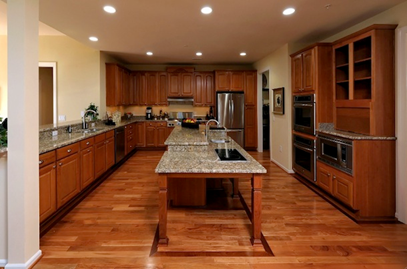
Universal Design plays a significant role in the future accessibility of all home designs. Homeowners must base design decisions on the seven (or eight) principles of Universal Design. Deciding which universal features to include in future forever homes is the most alluring question. Each principle is very useful in itself. The more principles involved in the design process, the greater the adaptable outcome of the home. After all, the smart forward thinking homes of the future depict long term sustainable assets for life allowing Aging in Place to seamlessly follow as people age and evolve. It is true Universal Design emerged out of the accessible and adaptive architectural movement; however, it constantly attempts to combine aesthetics with basic core values for every user. While moving us toward an accessible future, appearing invisible, Universal Design recognizes peoples’ bodies, needs, and lifestyles constantly change along a continuum due to the aging process. Universal Design acknowledges too that everyone ages differently as individuals. One person’s disability type is not experienced like another’s. It is better to live in a more open and comfortable Universal Design home with the flexibility of evolving with the homeowner rather than one which at some uncertain time becomes an impasse during the homeowner’s lifetime.

Embracing Universal Design with its many values and advantages for all people during timely remodeling projects or while building a new home is needed if society is ever going to escape the inaccessible cookie cutter homes of today. Additionally, this design technique offers a win-win solution helping solve problems encountered by multi-generational households. The multi-generational homes of today create the greatest personal accessibility challenges for all the generations involved. The application of Universal Design principles is desperately needed to sustain the choice of living environments for these diversified families. Universal Design homes have the unique ability of simultaneously accommodating strollers, walkers, or wheelchairs within the home without regard to a person’s size, age, or abilities. Furthermore, these homes contain lasting value if the owner ever decides to sell appealing to all society groups. To the uninformed, the folklore associated with Universal Design has stigmatized the process in home building today. This has much to do with why such a unique building concept is not greeted with open arms by the consumer. Beliefs like, it costs more, it takes up too much space, it will make my home have less resale value, it will look institutional, or only a few people could benefit from it represent a select few.
While Universal Design sounds appealing in conversations, it is rare to actually witness it in the built environment. The Universal Design movement recognizes its slow acceptance hinges on historic ties related to being a disability solution. This way of thinking causes implications for consumers and the world of home design presenting a huge misconception. Universal Design never distanced itself from the need for increased accessibility during the disability movement of the 80’s and therefore is mired in ADA jargon producing an indelible unfocused brand. As an inclusive design, Universal Design pertains to overcoming the barriers and stereotypes associated with its terminology in order to stand out as the next and final trend in future housing. Universal Design has no limits for the varying groups of people it helps. Every family member is included when using this design methodology whether they are abled or disabled, short or tall, young or old. With education, people understand Universal Design is the most revolutionary element in housing design today. Once realized how the principles of Universal Design affect everyone in the quest for maximum inclusion, consumers might start paying better attention to this logical building concept. Future home dwellers are fortunate in having this transitional and adaptable design concept in their vocabulary. Possibly they distinguish the designs flexibility as the gateway for tomorrow homes built and designed for everyone at every age. Only then, when people grasp the importance of Universal Design, does it become an everyday building term and a much needed household solution. No longer are personal desires for Aging in Place creating total disruption during life’s waning years. It is successfully accomplished seamlessly following the accessibility offered by Universal Design.

Tags:
ADA compliant kitchen cabinets,
accessible routes,
barrier free access,
wheelchair accessible baths and kitchens,
CAPS certification,
custom walk in showers,
ADA kitchen cabinets,
wheelchair accessible baths,
CAPS professional in Austin,
Universal Design,,
aging in place specialist,
aging in place design,,
handicap accessibility,
roll in showers,
accessibility designs Austin Texas,
roll in showers in Austin,
universal design/build,
universal design ideas,
Austin Accessibility Design,
certified aging in place consultant in Austin,
aging in place specialist in Austin,
universal design building for a lifetime,
what is universal design,
home accessibility help in Austin,
universal design kitchen ideas,
universal design remodeling techniques,
universal design remodeling contractor,
why is universal design important,
universal design principles,
7 principles of universal design,
universal principles of design,
Universal Principles of design revised and updated,
principles of universal design,
applying principles of universal design in Austin,
special needs contractor in Austin,
disability and special needs contractor Austin,
bathrooms with disability access in Austin, Texas,
ADA compliant wheelchair accessible showers,
disability access contractor,
barrier free showers in Austin,
ADA compliant roll in showers,
wheelchair accessible shower stalls,
roll in shower,
accessible bathroom design specifications,
wheelchair accessible toilets,
barrier free toilets,
handicap accessible toilets,
what is ada compliant,
home access,
accessible homes,
home access in Austin,
universal design/build contractor,
universal design vs. aging in place,
universal design contractor,
accessible design,
why universal design,
wheelchair accessible housing,
handicap accessible housing,
accessible homes in austin,
accessibility home modifications,
wheelchair accessible bathroom,
handicap bathroom design,
modifying your home for a disabled child,
accessible home builder in Austin,
wheelchair accessible homes,
universal home design in Austin,
the basics of aging in place,
how the life cycle affects aging in place,
applying universal design,
maneuvering in and around the accessible home,
Universal Design Garages,
Universal Bathroom Design,
Universal Design Bedroom,
universal kitchen design,
wheelchair accessible kitchens,
universal design kitchen,
barrier free kitchens,
disability access kitchens,
the universal design laundry,
barrier free laundry,
future home building using universal design,
universal design home builder,
universal design home additions,
barrier free design,
barrier free home design
Architects and designers with the help of CAPS professionals have been revising design basics in the recent past, creating design principles and strategies that accommodate the full range of human capability. This field of flexible or inclusive design is called Universal Design and its goal is to create easily accessible living and working spaces. Instead of appearing as a hospital extension, the designs are appealing and stylish and comfortable for everyone, not just the severely disabled among us. The world of boundaries and barricades is beginning to lessen and catch on nationwide one home at a time. This is a testament to the disabled population demanding equal access as the ADA rules which came about in 1990. Unfortunately the ADA rules do not apply to the residential market and disabled homeowners need to depend on the knowledgeable CAPS certified private sector of builders and remodelers. Every home should be accessible to all inhabitants and their visitors regardless of their age, size, or physical abilities. Caring for someone with special needs is a unique and sometimes lifelong challenge. Whether it’s a child born with a disability, someone who has suffered an unfortunate accident or medical event causing them to lose abilities they once had, or an older family member in declining health needing assistance with daily life, the work of a special needs contractor can help make things easier for both the affected individual and their caregivers.
Handicap Bathroom Vanity In Austin

T- Square Company located at 14141 Highway 290 West, Suite 800 in Austin, Texas is an industry leading accessible, universal, certified Aging in Place and VA approved Specially Adapted Housing accessible home builder and remodeler. We offer design/build projects for both totally accessible homes from the ground up and complete handicap modifications for existing homes to age in place. Traditional home builders and remodelers do not consider or understand the needs of the disabled or elderly. They deal mainly with the two thirds of our society without disabilities. They do not have the knowledge or experience required to think out of the box when creating a special needs home. It requires an educated accessible home builder and contractor to realize special needs for special people. T-Square Company will design and build you an adapted living environment which is completely customized toward your abilities. Whether your project concerns home modifications, an accessible addition or wing, or new construction derived from a handicap accessible floor plan we can help you increase your accessibility. We are CAPS certified (1636580) and have over three decades of building and remodeling experience practicing as a disability contractor for special needs. We want to help our clients be as self sufficient and independent as possible. Let us show you how to increase the safety and accessibility within your personal living environment.

When mobility becomes an issue for any homeowner, regardless of age, the question arises concerning physically moving to a different home with a bath that is more accessible or making the existing home modifications which will meet the need of new life changes. Solving aging in place issues will soon become the number one challenge concerning the present out-of-date housing inventory in our country. Our present day obsolete homes now inhabited by the baby boomer generation will slowly and increasingly raise their outdated and obsolete ugly heads and expose their true lack of kitchen or bathroom accessibility to those very people inhabiting them. The situation will only become ever more expanding in time. When these homes were previously purchased, they represented an absolute castle in the world of their owners in which to prepare for a day and they also acted as a retreat from life's tough interactions. They housed our families, our memories, and our stuff. They represented a place where we could be ourselves. Our homes have always been exempt from any and all of the accessibility regulations that have been put in place since 1968 when our Viet Nam veterans were returning home. The new evolving concept known as Universal Design and the increasing number of specialized handicap remodeling contractors for home remodeling is catching on nationwide and has been for several years as a sign of the times. Universal design techniques used in building makes a home more accessible to all regardless of their mobility or adaptive abilities.
Contact T-Square Company today at 512-444-0097 so we can show you how to begin a new accessible chapter in your lifetime.
Tags:
handicap accessible bathroom remodeling,
Austin aging in place specialist,
handicap bathroom remodel,
accessible home remodeling for disabilities,
barrier free showers in Austin,
ADA compliant roll in showers,
handicap ADA roll in shower,
wheelchair accessible shower stalls,
accessible bathroom design specifications,
home remodeling contractors residential,
disabled bathroom remodel,
specialty construction in Austin,
what is an ADA compliant bathroom,
home access in Austin,
home accessibility,
wheelchair accessible housing,
accessible homes in austin,
accessible home modifications,
wheelchair accessible bathroom,
handicap bathroom design,
handicap bathroom vanity,
handicap bathroom contractor in Austin,
handicap accessible floor plans,
accessible home builder in Austin,
special needs contractor,
universal home design in Austin,
home renovations for disability in Austin
T- Square Company in Austin, Texas is an industry leading accessible, universal, certified Aging in Place and VA approved Specially Adapted Housing custom home builder and remodeler. We offer both new totally accessible homes and complete handicap modifications for existing homes. Traditional home builders and remodelers don't really consider the needs of the disabled or elderly like ADA vanities , roll in showers, or specially adapted kitchens which are universal in nature. It takes a special breed of contractor to realize special needs for special people.
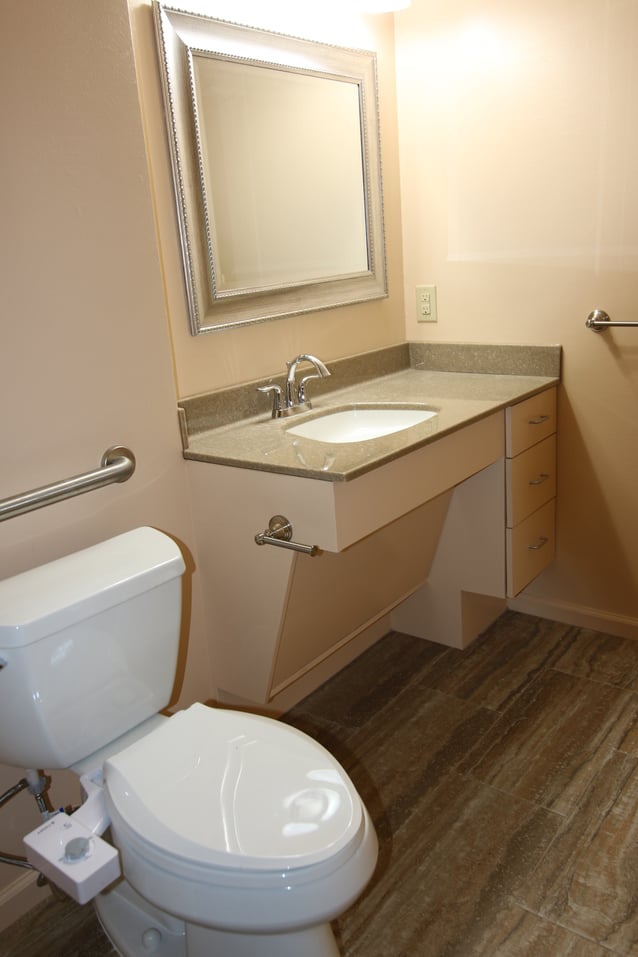
A revolution in building design standards is long overdue. Our current building design standards do not address the needs of more than one third of our existing population. Many more people can greatly benefit from accessible design versus conventional design. Our rapidly aging population is experiencing the limitations of our personal living environments. Any evolution in building practically always begins in the common areas of the commercial building sector. The American Disabilities Act of 1990 increased the attention needed for those people having the right to equally access their work place and any recreational or leisure facilities. These rules at least offer minimal solutions for those needing the most help with any building access. In Austin, we now must provide access to one bathroom on the first floor in new homes as deemed by our newly adopted building regulations. This basic right to a handicap accessible bathroom is finally being enforced by the city's building inspectors. What a tremendous needed and basic design improvement!
Finding the right design/build contractor with ADA knowledge and experience can be a challenge. Obtaining help for maintaining your independence throughout an accessible wheelchair design in Austin is possible. You should be looking for a CAPS certified contractor who understands life changes. A local contractor who offers specialty products and services standing out from the rest of the pack. A contractor who has the ability, through experience, to help clear the murky water impeding your accessible route and how it can be accomplished. One who takes ADA remodeling to another level promoting safety. A well versed construction professional can take on and solve any residential ADA challenge creating handicap accessible house plans. These can include widening doorways, ADA compliant kitchen cabinets, or ADA compatible baths.

Accessible floor plans can include level no step entries, wider hallways and doorways, adequate maneuvering space for a wheelchair turning radius throughout the home, non-slip flooring, ramps to overcome level changes, clear unobstructed walkways, special area lighting, accessible closets and storage, roll out or pull out shelving, easy grab door hardware, automatic and graspable faucets, full extension drawers, accessible switches and outlets, roll in showers, ADA roll under vanities, counter tops, and work spaces, accessible kitchen appliances, and many other specialty features designed around the homeowner's abilities.
A handicap accessible house plan takes the special needs of the physically disabled into consideration throughout the entire design. This type of home layout typically includes fewer walls, more open space, and wider hallways for increased mobility throughout the home for those that require the use of a wheelchair.
The Americans with Disabilities Act (ADA) ensures that public spaces are designed to accommodate disabled patrons, and this type of home does as well. After all, living with a disability presents many challenges, as the ADA acknowledges, and navigating the home shouldn't be one of them. The home shouldn't ever make the homeowner feel like a prisoner within it's walls.
Aging in place construction and Austin ADA remodeling has become synonymous with handicap accessible home design and modification during our lifetime. Home modifications can be used to accommodate anyone from people with mobility impairments to those with vision loss, hearing loss, or even cognitive or developmental disabilities. Accessibility home modifications or wheelchair accessible kitchen and bathroom remodeling in Austin will allow anyone with limited mobility within your home to feel more empowered and independent. The extent of a customized accessibility design is dependent upon the activity level of the person requiring the modifications.

Today's conventional building standards conflict with most people's accessibility when you consider our created architectural barriers concerning cabinetry and door opening widths, individual strength, range of motion, movement, manual dexterity, balance, and coordination. Once the demands of our built environment exceed their capacities we become excluded from a room or even the entire home. The building world must work in unison to be sure the entire living environment meets basic needs in addition to affordability and structural integrity for the consumer and home owner. This includes both the home and the components within the home being accessible to all inhabitants. Privacy, sense of belonging, sense of control, and the sense of safety and security make up the quality of life for any home and should be considered for any design increasing home accessibility.
Tags:
barrier free remodeling,
handicap remodeling,
disability remodeling,
handicap access bathroom remodel,
ADA compliant wheelchair accessible showers,
disability access contractor,
home modifications for Austin veterans,
veterans home accessibility help in Austin, Texas,
ADA compliant roll in showers,
wheelchair accessible shower stalls,
accessible bathroom design specifications,
specialty construction in Austin,
what is ada compliant,
home access,
accessible homes,
what is an ADA compliant bathroom,
home access in Austin,
bathroom remodeling contractors Austin, TX,
bathroom remodel contractors,
universal design/build contractor,
universal design vs. aging in place,
universal design contractor,
home accessibility,
accessible design,
why universal design,
what is universal design in Austin,
what is aging in place,
wheelchair accessible housing,
accessible housing,
handicap accessible housing,
handicap accessible house plans,
accessible homes in austin,
universal design techniques,
Austin home remodeling for disabled,
accessibility home modifications,
accessible home modifications,
wheelchair accessible bathroom,
handicap bathroom design,
handicap bathroom requirements,
handicap bathroom vanity,
modifying your home for a disabled child,
wheelchair access,
handicap bathroom contractor in Austin,
handicap accessible floor plans
Life happens and your present way of going about it includes newly discovered physical barriers which were never an issue before. You've lost your mobility and are now forced to rely on a wheelchair for assistance at least for the present time. The maneuvering of familiar areas within your home you'd always taken for granted are now presenting barriers that are limiting your new means of mobility. Clear openings of 32" or greater, elevation changes steeper than 1:12, and being able to have access to all your home's facilities have been affected springing forth handicap remodeling. The removal of these home grown barriers that now disrupt your accessible route for handicap bathrooms in Austin, Texas needs to be done by a qualified building professional holding a CAPS certificate. Any ADA remodeling should comply with both ADA and local building code standards along with the TDLR guidelines. A handicap bathroom remodel is not age related but becomes a major aspect concerning remodeling for seniors.

Problems encountered while accessing your home when you are wheelchair bound generally begin before or at the front door. Given that you can reach the front porch approach without obstruction is surely a great start. The stairs leading onto the front porch are yet another matter all together. A correctly designed ramp having the correct slope can adequately solve this problem. The use of grab bars and any railings will be dictated by the ramp's design and the regulations involved. Once your safely upon the porch, your home's front door width can become an issue. Any entry door less than three feet in width will cause a problem in maintaining a required 32 inch clear entry way that starts the new accessible route within your home. Once inside the structure a new set of problems concerning your accessibility will be discovered.

An accessible bathroom for your convenience becomes the first issue. The disability access bathroom will be located within the accessible route. Any barriers encountered while approaching the bathroom entrance will need to be removed. The minimum clear widths have to be observed. This will include the bathroom door itself. Twenty four to twenty eight inch wide doors are commonly used during the construction of American homes for accessing the bathroom and must be widened during a bathroom transformation. Anything below three feet does not meet the clear 32 inch requirement mentioned above and will need to be altered for clearance of your wheelchair. This work may involve moving light switches. These alterations should be done by a licensed electrician assuring your safety.
Once inside the accessible bathroom you should try to maintain a five foot turning radius for your wheelchair if at all possible. You will need to have your plumbing facilities brought into compliance to enable your freedom and safety. Bathroom modifications for the disabled involve the use of grab bars within the tub or shower and around the toilet which can be very helpful insuring your safety for maneuverability. These should be installed at 34 inches above the finished floor to safeguard your use of them. Having roll under capability for the new 34" high ADA compliant vanity can be very helpful while you are in the wheelchair. Exact clearances should be complied with underneath the vanity. The proper safety equipment should be installed on the plumbing pipes that don't allow scalding of your legs. The toilet may need to be replaced providing a comfort level height for easier access. The handicap bath or roll in shower may need to be altered to become only a shower with roll in or possibly transfer capabilities. Roll in showers are always easier to deal with than handicap baths having walk in ability. However, these tubs are not for everyone especially those with dementia so do your homework before buying such an expensive addition to your bathroom. All of these changes must be done along the ADA guidelines for your safety but these are only to be used as a reference. At this point every individual has their own set of needs according to their disabilities.
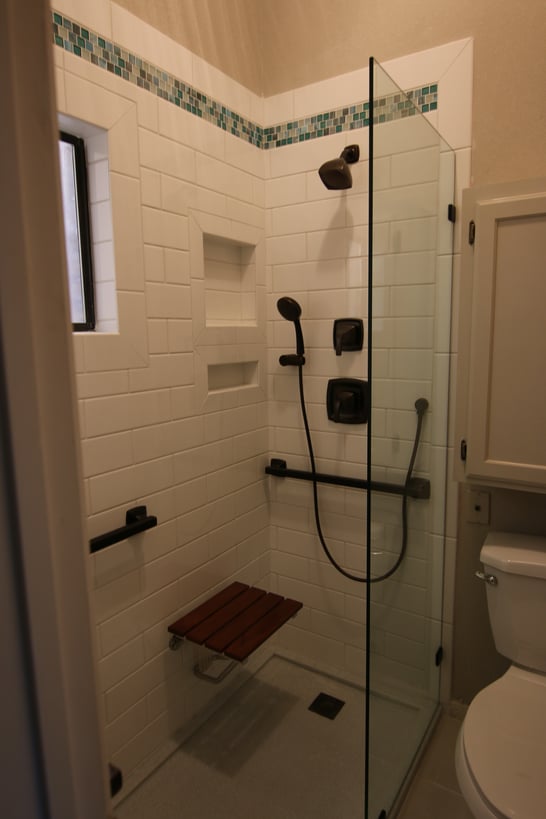

The referenced door situation above will be true for any room in the house if you are to enter them barrier free. The kitchen, your bedroom, and any other rooms you require accessibility to enter could be affected. Even the closet door within your bedroom will need to be wide enough so that you can manage getting your clothes to dress. Any other bedrooms that you may need to enter with your wheelchair will need alterations.
The accessible kitchen is another story altogether. You will at least need the roll under capability as mentioned above at the sink. Upper kitchen cabinet heights may become an issue if you still plan to do meal preparations. No matter what you end up doing, make sure to hire an experienced building professional who understand the ADA guidelines for your well being.
Aging in place design is mostly used for homeowners who require home modifications to allow them to remain in their home safely and comfortably as they age while their physical abilities change over time. Universal design is a much broader term covering the design of products and environments that are usable by all members of the household, from the youngest to the oldest, to the largest extent possible, without the need for further alterations, adaptations, or specialized design. Universal Design provides a pathway to seamlessly age in place. It is truly thinking ahead when it comes to accommodating the living environment for better home access.
Aging in place home modifications are available through T-Square Company in the Austin area. We have an A plus rating with the local BBB and have over 30 years of remodeling experience. We are additionally a certified aging in place specialist (CAPS) offering complete aging in place services. Each design/build situation will be customized to fit your personal needs increasing your accessibility. Call 512-444-0097 today to begin the accessible second chapter of your life while remaining safe and secure in your existing home. CAPS #1636580
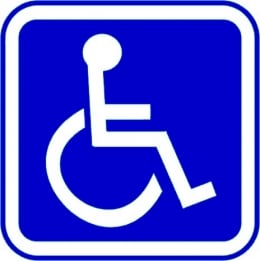

Tags:
Austin,
Texas,
ADA compliant kitchen cabinets,
ADA accessible,
accessible routes,
ADA bathroom cabinets accessible routes,
barrier free access,
aging in place home modifications,
aging in place home improvements in Austin,
ADA remodeling,
ADA bathroom cabinets,
ADA compliance,
ADA kitchen cabinets,
accessibility home remodeling in Austin,
accessible home remodeling,
Austin bath remodeling,
Austin kitchen remodeling,
disability home remodeling in Austin,
aging in place specialist,
aging in place services,
aging in place design,,
elder construction,
handicap remodeling contractors in Austin,
independent living in Austin Texas,
handicap home modifications for disabled,
ADA vanities,
barrier free remodeling,
handicap accessible bathroom remodeling,
handicap accessible home modifications,
handicap accessible bathroom remodel,
handicap access bathroom remodel,
handicap accessible bathroom shower,
handicap bathroom remodel,
ADA compliant wheelchair accessible showers,
home modifications for Austin veterans,
ADA compliant roll in showers,
wheelchair accessible shower stalls,
accessible bathroom design specifications,
professional remodeling contractor,
professional remodeler,
home remodeling contractors residential,
disabled bathroom remodel,
home remodeling contractor residential,
what is ada compliant,
home access,
accessible homes,
what is an ADA compliant bathroom,
Austin bathtub to shower conversions,
Austin tub conversions,
bathroom remodeling contractors Austin, TX,
bathroom remodel contractors,
bathroom remodel contractors near me,
bathroom remodel contractor,
handicap accessible housing,
accessible homes in austin,
Austin home remodeling for disabled,
accessibility home modifications,
accessible home modifications
Finding the right design/build contractor with ADA knowledge and experience can be a challenge. Obtaining help for maintaining your independence throughout an accessible wheelchair design in Austin is possible. You should be looking for a CAPS certified contractor who understands life changes. A local contractor who offers specialty products and services standing out from the rest of the pack. A contractor who has the ability, through experience, to help clear the murky water impeding your accessible route and how it can be accomplished. One who takes ADA remodeling to another level promoting safety. A well versed construction professional can take on and solve any residential ADA challenge creating handicap accessible house plans. These can include widening doorways, ADA compliant kitchen cabinets, or ADA compatible baths.

Concerning home accessibility, door widening is a common problem especially where wheelchair access is a must. All doors should be 36" wide with the correct locking hardware installed. The rule is 32" clear within the accessible route but 32" doors don't give enough clearance because of their stops. You also need to pay attention to which side the lockset is installed on to not limit any wheelchair access or operation of the door's locking hardware.
ADA compliant kitchen cabinets give you the ability to freely roll under the correct depth sink with covered or insulated water and drain lines. The sink should be equipped with a proper automatic or wrist handle faucet. A finished cabinet top height of 34" will also be observed. Wall cabinets should be mounted around 4" lower than usual for reachability from a sitting position. An unobstructed five feet turning radius on the floor should also be maintained.

Bathroom transformations complying with ADA revisions also require the same turning radius noted in the kitchen along with a correct bathing facility. If a tub is useful, correctly placed grab bars must be installed for safety reasons. Showers can be either the roll in or transfer type dictated by the individual user's physical abilities. The comfort height toilet should have grab bars installed at 34" on the side wall as well as at the rear at a minimum. The flush handle should be oriented toward the middle of the room away from the side wall. The bathroom sink should be accessible as in the kitchen mentioned above.
A Correct Kitchen Sink With Adequate Knee Clearance in The Accessible Route
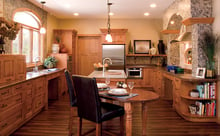
Traditional home builders and remodelers don't really consider the needs of the disabled or elderly like ADA vanities or roll in showers which are universal in nature. It takes a special breed of contractor to realize special needs for special people.
A revolution in building design standards is long overdue. Our current building design standards do not address the needs of more than one third of our existing population. Many more people can greatly benefit from accessible design versus conventional design. Our rapidly aging population is experiencing the limitations of our personal living environments. Any evolution in building practically always begins in the common areas of the commercial building sector. The American Disabilities Act of 1990 increased the attention needed for those people having the right to equally access their work place and any recreational or leisure facilities. These rules at least offer minimal solutions for those needing the most help with any building access. In Austin, we now must provide access to one bathroom on the first floor in new homes as deemed by our newly adopted building regulations. This basic right to a handicap accessible bathroom is finally being enforced by the city's building inspectors. What a tremendous needed and basic design improvement!

Aging in place construction and Austin ADA remodeling has become synonymous with handicap accessible home design and modification during our lifetime. Home modifications can be used to accommodate anyone from people with mobility impairments to those with vision loss, hearing loss, or even cognitive or developmental disabilities. Accessibility home modifications or wheelchair accessible kitchen and bathroom remodeling in Austin will allow anyone with limited mobility within your home to feel more empowered and independent. The extent of a customized accessibility design is dependent upon the activity level of the person requiring the modifications.
Aging in place home modifications are available through T-Square Company in the Austin area. We have an A plus rating with the local BBB and have over 30 years of remodeling experience. We are additionally a certified aging in place specialist offering complete aging in place services. Each design/build situation will be customized to fit your personal needs increasing your accessibility. Call 512-444-0097 today to begin the accessible second chapter of your life while remaining safe and secure in your existing home. CAPS #1636580
Tags:
Texas,
kitchen remodeling,
how-to,
ADA compliant kitchen cabinets,
ADA accessible,
accessible routes,
ADA bathroom cabinets accessible routes,
wheelchair accessible remodeling,
wheelchair accessible baths and kitchens,
ADA remodeling,
ADA bathroom cabinets,
accessibility home remodeling in Austin,
accessible home remodeling,
Austin bathroom remodel,
home modifications for independent living,
handicap remodeling contractors in Austin,
remodel bathroom for handicap Austin Texas,
handicap home modifications for disabled,
handicap remodeling contractors,
home modifications Austin, Texas,
ADA remodeling Austin, Texas,
ADA bathroom Austin, Texas,
age in place home design,
home remodeling for disabled,
wheelchair accessible home remodeling in Austin,
remodeling for elders in Austin,
disability contractor in Austin,
disability and special needs contractor Austin,
handicap accessible remodeling,
handicap remodeling,
disability remodeling,
roll in shower design for wheelchair access,
disability access contractor,
ADA compliant roll in showers,
roll in shower,
accessible toilets,
handicap accessible toilets,
home remodeling professional,
specialty construction in Austin,
home access,
accessible homes,
Austin bathtub to shower conversions,
Austin tub conversions,
bathroom remodeling contractors Austin, TX,
bathroom remodel contractors,
universal design/build contractor,
home accessibility,
wheelchair accessible housing,
accessible housing,
handicap accessible housing,
handicap accessible house plans
If you have been considering a fine bathroom makeover or remodeling project in Austin there are a few things you should take into consideration. Bathroom remodels in Austin, Texas can take on many looks and facets. The scope of work you choose to accomplish should effectively solve your problems and most importantly, your needs as the home owner. The identification of these specific needs belongs to you the home owner. The way your home is structurally altered to accomplish these needs is the job of the professional remodeling contractor. Bathroom accessibility should be a concern no matter what your age. If your concerns are not for you, barring any life changing accident, they could concern the accessibility of another generation's independence is using the restroom. CAPS professionals in the remodeling industry can help with solutions in solving these issues.


How about your tub? If it is no longer used or you have another tub in your other bathroom it can be transformed into a shower within the same footprint. You'll need to decide if you want a door and bring in the sides for the correct opening with either glass blocks or custom tile work on stick frame type construction. A custom walk in or roll in shower without a door requires a large enough area to enter so that the shower head is off to the side. Today's showers can get pretty fancy with body and rain heads but remember these require a larger size water supply line than is normally supplied. Liners or pans beneath the floor tile can be composed of either a custom fiberglass application or the proper vinyl material. Waterproofing is the most important aspect of shower building and all precautions must be taken. One piece above the slab shower bases can solve any future problems that might arise using any type of shower pan. These can be equipped with add on ramps for wheelchair access if the floor slab construction will not allow lowering the shower floor for roll in capability.
Certainly there are many upgrades available when planning a bathroom transformation. A custom tub shower conversion for the replacement of the tub with a new walk in or roll in shower can create a bold look but will run you around $13,000. There are no spending limits for bathroom remodels. You can plan on spending around $12,000 to $15,000 for a hall bath remodel. The price tag can approach or exceed $35,000 for a complete master suite remodel. The type of fixtures and building components chosen along with the labor will compose the overall cost of the remodeling project.
Keep in mind that moving plumbing, especially drains, is one of the more expensive aspects of a fine bathroom makeover involving floor demolition. If you can limit and control the costs involved with this issue you will have more money to spend on the things that show off your endeavors. Changing water supply line locations is not as difficult as moving drains especially when they go into the main drainage system that resides underneath the finished floor.

Bathroom plumbing fixture choices are numerous to say the least. Select reputable companies offering the best warranties especially when considering finishes used on control valve trims and the fixtures installed in the project. Larger walk in shower designs should have seamless fiberglass liners to avoid leaks if the house ever shifts. Using natural stone or glass tiles while additionally designing in glass blocks will certainly be an upgrade. As for the new walk in shower design, you can design the space to not need a door for splash protection or you can take the route of a clean looking frameless glass shower enclosure. This will surely set you back at least $900. The end result will be a sophisticated clean look of beauty enclosing your new shower. Whether the door sits upon a curb or you have a specific need for a curbless situation you will be satisfied with your choice.
All new construction or any Austin bathroom remodel should involve multiple shower head combinations in multiple locations to fit anyone's desires. Rain heads coming out of the ceiling, body heads coming out of the walls in many locations, or hand held units attached to the shower walls can make things very interesting. These combinations of heads and locations can be used to create rain effects, provide relief for muscle aches through body massages, or simply provide pin point convenience with hand held variable heads. The possibilities are endless as you dial in your bathing environment. Steam generators are also being considered as an investment in today's fine bathroom designs. The steam heads can make the difference after a tough day when you're looking for that more therapeutic spa experience. This has certainly led the way to the thermostatic shower valve with plumbed-in hand held shower that is being
Who do you choose to help you with your dream? It is true that a professional remodeling contractor with years of experience will cost you more than a handyman illegally operating among the tradesmen at your peril; but then again, there are those professional guarantees to consider. The professional verses the handyman is more likely to seek your overall satisfaction that will follow him into his next job. A true building professional can also orchestrate the job's smooth flow limiting the down time of a most useful room. Subcontractors will not be covered up and each skilled trade is brought onto the sight as needed in an orderly fashion. Professionals normally have insurance to cover on the job accidents to protect the homeowners from having legal action brought against them personally. Be sure you ask for a certificate of insurance from your chosen professional contractor so that you aren't held personally liable for medical experiences covering a worker's accident while on your property. Don't forget that only a certified aging in place (CAPS) professional can help you solve your accessibility issues.used specifically in homes today where the owner is planning to retire.
The National Association of Home Builders, in partnership with the AARP and Home Innovation Research Labs, created the CAPS program, which includes training and education on the technical, business management and customer service skills essential to compete in the fastest growing segment of the residential remodeling industry--home modifications for aging in place and ADA accessibility in Austin, Texas. David L. Traut, CAPS the owner of T-Square Company in Austin, Texas is one of the select group of professionals nationwide to earn the Certified Aging-In-Place Specialist (CAPS) designation, identifying him as a home remodeler and builder with the skills and knowledge necessary to remodel or modify a home to meet the unique needs of the older population, disabled owners, or their visitors. The Austin office number is 512-444-0097. Call for an appointment.
Tub To Shower Conversions In Austin, Texas
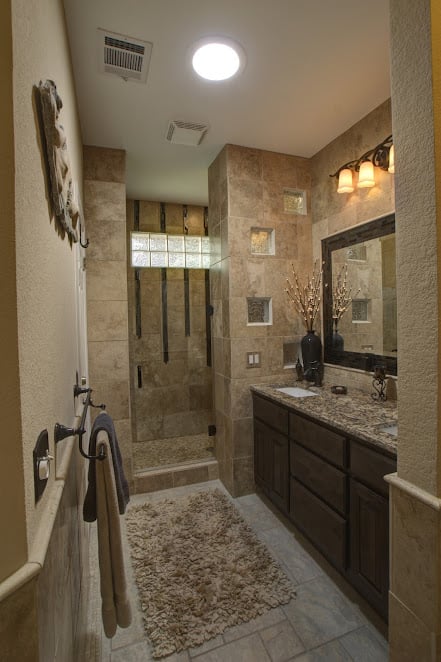

Wheelchair Accessible Showers In Austin
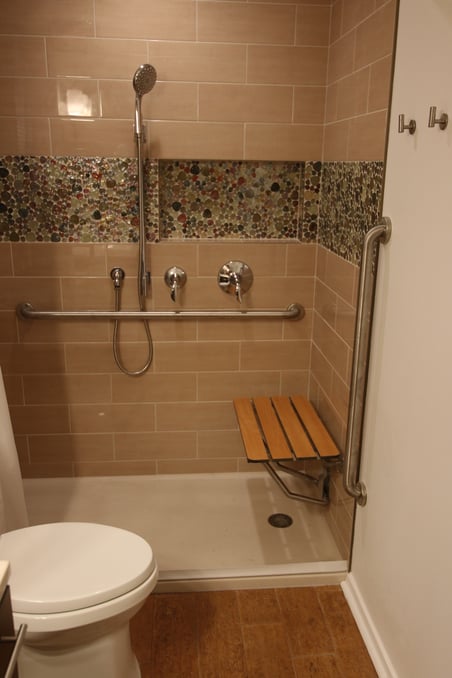

Tags:
Austin,
Texas,
residential remodeling,
bathroom remodeling,
wheelchair accessible remodeling,
handicap home modifications,
fine bathroom upgrades,
bathroom remodels,
CAPS certification,
ADA remodeling,
custom tub to shower conversions,
home modifications for independent living,
handicap remodeling contractors in Austin,
remodel bathroom for handicap Austin Texas,
handicap home modifications for disabled,
handicap remodeling contractors,
wheelchair accessible showers in Austin,,
Austin walk in shower,
walk in shower Austin,
roll in showers,
glass block shower designs,
roll in showers in Austin,
glass block design,
glass block bath designs Austin,
home remodels Austin,
bathroom modifications for disabled in Austin, TX,
home modifications for children with disabilities,
custom walk in shower in Austin,
austin texas wheelchair accessible showers,
Austin handicap bathroom contractor,
handicap accessible bathroom remodel,
ADA compliant wheelchair accessible showers,
roll in shower design for wheelchair access,
barrier free showers in Austin,
ADA compliant roll in showers,
handicap ADA roll in shower,
wheelchair accessible shower stalls,
roll in shower,
home remodeling near me,
home remodeling contractors residential,
Austin bathtub to shower conversions,
Austin shower remodel,
Austin shower conversions,
Austin tub conversions
When mobility becomes an issue for any homeowner, regardless of age, the question arises concerning physically moving to a different home with a bath that is more accessible. Preparing for one of those highly likely events involving someone in your home needing room modifications for even a short time while recovering from surgery is surely a smart move. Solving aging in place issues will soon become the number one challenge concerning the present obsolete housing inventory in our country. Our present day obsolete homes now inhabited by the baby boomer generation will slowly and increasingly raise their outdated and obsolete ugly heads and expose their true lack of kitchen or bathroom accessibility to those very people inhabiting them. The situation will only become ever more expanding in time. When these homes were previously purchased, they represented an absolute castle in the world of their owners in which to prepare for a day and they also acted as a retreat from life's tough interactions. They housed our families, our memories, and our stuff. They represented a place where we could be ourselves. Our homes have always been exempt from any and all of the accessibility regulations that have been put in place since 1968 when our Viet Nam veterans were returning home.
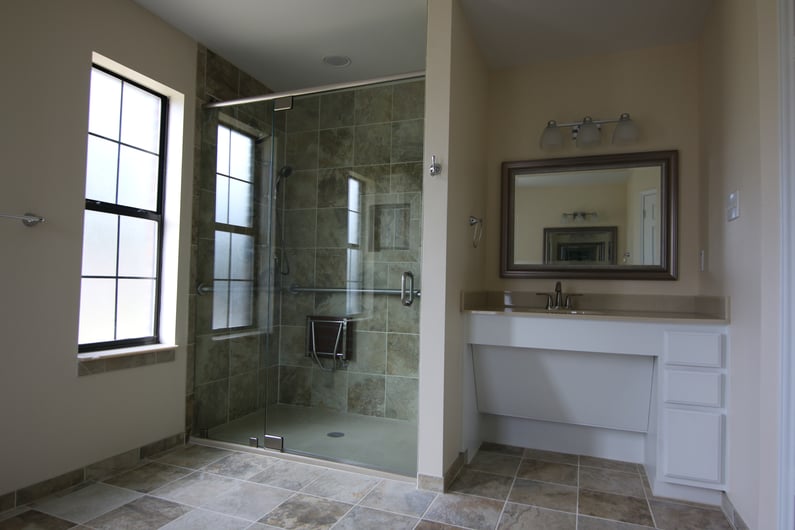
The new evolving concept known as Universal Design and specialized handicap remodeling contractors for home access remodeling is catching on nation wide and has been for several years as a sign of the times. Universal design techniques used in building makes a home more accessible to all regardless of their mobility or adaptive abilities. An evolution of new products used for disability home modifications is making those homes more accessible and has finally come about in the remodeling industry. These new advances in accessible home remodeling in Austin not only keep the living environments safer but will not compromise the home's aesthetics. In fact, there are many benefits to using universal design techniques, including potential use by aging family members, added resale value, and the fact that you'll be creating a space that can be used by anyone who visits your home, regardless of their range of abilities. Simple universal design updates for aging in place home modifications and handicap bathroom accessibility can include adding grab bars or handrails throughout the home, adding a seat within the roll in shower, lowering upper cabinets and counter tops, adding non-slip flooring, widening hallways or installing stair lifts, and widening doors. Many people find themselves needing accessible homes for themselves or family members. There are approximately 30 million Americans using wheelchairs and the number of people who need accessible homes will continue to increase as disabled and aging people are finding more ways to remain living in their homes. One important way to increase independent living is making a home accessible to an individuals personal needs. Home modifications can increase safety, accessibility, and independence for people who want to live independently.

The National Association of Home Builders, in partnership with the AARP and Home Innovation Research Labs, created the CAPS program, which includes training and education on the technical, business management and customer service skills essential to compete in the fastest growing segment of the residential remodeling industry--home modifications for aging in place and ADA accessibility in Austin, Texas. David L. Traut, CAPS the owner of T-Square Company in Austin, Texas is one of the select group of professionals nationwide to earn the Certified Aging-In-Place Specialist (CAPS) designation, identifying him as a home remodeler and builder with the skills and knowledge necessary to remodel or modify a home to meet the unique needs of the older population, disabled owners, or their visitors.
If you ever find yourself needing better accessibility within your home during a recuperation or as a general more permanent need please don't hesitate to reach out to me directly.
Sincerely,
David

Tags:
residential general contractor Austin, Texas,
home accessibility help in Austin,
home remodeling for disabled in Austin Texas,
wheelchair accessible home remodeling in Austin,
universal design remodeling contractor,
principles of universal design,
Austin Senior Home Remodeling,
disability contractor in Austin,
disability and special needs contractor Austin,
home modifications for elderly in Austin,
bathrooms with disability access in Austin, Texas,
Austin disability contractors for special needs,
Austin handicap bathroom contractor,
handicap accessible remodeling,
handicap remodeling,
handicap accessible home renovations,
disability remodeling,
handicap accessible bathroom remodel,
handicap accessible bathroom shower,
ADA compliant wheelchair accessible showers,
disability access contractor,
home modifications for Austin veterans,
veterans home accessibility help in Austin, Texas,
ADA compliant roll in showers,
wheelchair accessible shower stalls,
accessible bathroom design specifications,
accessible toilets,
barrier free toilets,
ADA vanity height,
ADA Compliant grab bars,
professional remodeling contractor,
professional remodeler,
disabled bathroom remodel,
accessible bathroom remodel,
specialty construction in Austin,
home remodeling contractor residential,
home access,
accessible homes,
what is an ADA compliant bathroom,
home access in Austin
ADA wheelchair ramp guidelines are as follows:
- The minimum ramp width must be 36 inches minimum but 48 inches is preferable.
- Ramps must have edge protection to keep anyone from slipping off their surface in the form of a raised outer curb or railing.
- All wheelchair ramps must have level or flat unobstructed landings at the top and bottom of the rise being overcome that are 60 inches by 60 inches to provide a proper five foot wheelchair turning radius. The landing areas cannot have more than a 30 feet long ramp separating them. If the rise distance requires longer than a 30 foot run to overcome it then a series of landings can be used creating a switchback design.
- Thirty six inch handrails are required on both sides of all ramps that rise steeper than 6 inches from the ground below.
- All surfaces must be slip resistant and stable.
A wheelchair ramp is basically an inclined plane installed in addition to or instead of stairs. Ramps provide wheelchair users or users of other mobility aids as well as people pushing strollers,carts, or other wheeled objects, better access to any building. When designing a wheelchair ramp, you need to consider the users physical limitations. The ramp should be wide enough to be safe and maneuverable and sturdy enough to carry the weight of an electric wheelchair and it's cargo (this can approach 6-700 pounds in many instances) and have a slope that is gradual enough for a manual wheelchair user to navigate.
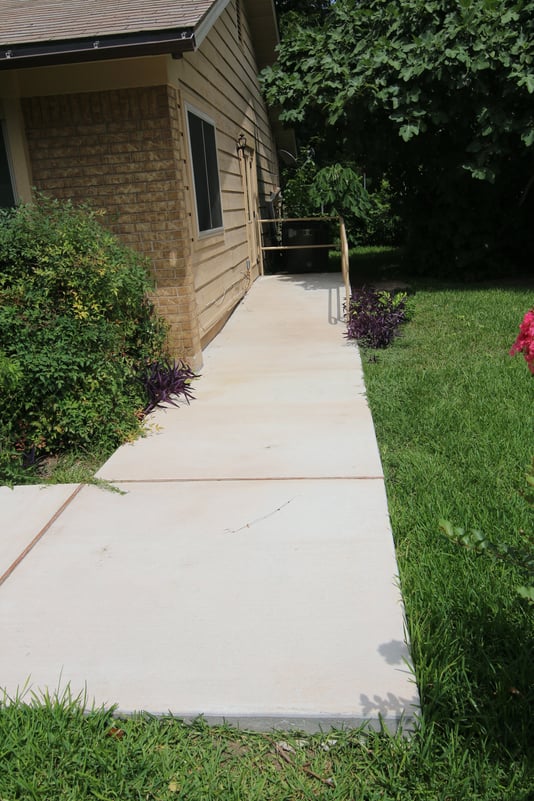
Let's say your front porch is 24 inches tall and you are needing easier access to your home while using a wheelchair or walker. A straight ADA prescribed 1:12 ramp will let you overcome the 24 inch porch rise over a span of 24 feet. This is as steep a ramp that is allowed but it may not work for everyone and it may need to be of less slope as in 1:16-1:20. However, if your porch is 36 inches tall, a maximum thirty feet long straight ramp will overcome only 30 inches of the rise of your porch and the remaining six inches can be overcome by an additional six feet long ramp which occurs only after a five feet by five feet flat turning area is installed. This is referred as a switchback and the additional six feet ramp can be added on any face of the flat area. It can be installed as a straight run or as a ninety degree turn in either direction. If adequate room isn't available for the above scenario, then the switchback can occur along the path of travel anywhere as long as the approaching ramp doesn't exceed thirty feet in length which is a maximum. Don't forget to include another flat 60" by 60" landing at the front door and at the end of the incline ramp to allow for greater maneuverability and door operation.

Upon entering the home, you can begin the accessible route which is designed to take you through the home to the most visited areas like the bathroom, kitchen, and living areas in that order. Our homes have always been exempt from any and all of the accessibility regulations that have been put in place since 1968 when our Viet Nam veterans were returning home. The new evolving concept known as Universal Design and specialized handicap remodeling contractors for home remodeling is catching on nation wide and has been for several years as a sign of the times. Universal design techniques used in building makes a home more accessible to all regardless of their mobility or adaptive abilities. An evolution of new products used for disability home modifications is making those homes more accessible and has finally come about in the remodeling industry.
The National Association of Home Builders, in partnership with the AARP and Home Innovation Research Labs, created the CAPS program, which includes training and education on the technical, business management and customer service skills essential to compete in the fastest growing segment of the residential remodeling industry--home modifications for aging in place and ADA accessibility in Austin, Texas. David L. Traut, CAPS the owner of T-Square Company in Austin, Texas is one of the select group of professionals nationwide to earn the Certified Aging-In-Place Specialist (CAPS) designation, identifying him as a home remodeler and builder with the skills and knowledge necessary to remodel or modify a home to meet the unique needs of the older population, disabled owners, or their visitors. Schedule an appointment by calling 512-444-0097 today.

Tags:
accessible routes,
barrier free access,
aging in place home modifications,
wheelchair accessible remodeling,
wheelchair accessible baths and kitchens,
handicap home modifications,
CAPS certified remodeling in Austin,
aging in place remodels,
handicap accessible bathrooms,
custom tub to shower conversions,
aging in place specialist,
disability home modifications in Austin,
Austin elder construction,
handicap home modifications for disabled,
home modifications Austin, Texas,
accessibility remodelers in Austin,
ADA bathroom Austin, Texas,
roll in showers,
roll in showers in Austin,
certified aging in place consultant in Austin,
senior aging in place services,
why is aging in place important,
what is universal design,
home remodeling for disabled,
remodeling companies in Austin TX,
wheelchair accessible home remodeling in Austin,
universal design remodeling techniques,
universal design remodeling contractor,
universal design principles,
remodeling for elders in Austin,
disability and special needs contractor Austin,
Austin disability contractors for special needs,
handicap remodeling,
handicap accessible home modifications,
roll in shower design for wheelchair access,
accessible home remodeling for disabilities,
veterans home accessibility help in Austin, Texas,
barrier free showers in Austin,
ADA compliant roll in showers,
handicap ADA roll in shower,
wheelchair accessible shower stalls,
professional remodeler,
specialty construction in Austin,
home remodeling contractor residential,
what is ada compliant,
home access,
accessible homes,
wheelchair ramp slope,
wheelchair ramp specifications,
ADA wheelchair ramp
No matter how old you are you should periodically evaluate your residence to determine whether it suits you not just for the present but the future. Your home assessments will be rethought every time your living situation changes. Whether childproofing for a newborn, making a home more accessible following a sickness or unfortunate accident to someone in the family, or making a toilet area safer for an aging residing parent, there will be an immediate evolution to your primary domicile. These same life span design features are even more important if you believe you're past the age of wanting to move and are relishing the thought of aging in your own home, no matter what physical limitations you might later develop. Incorporating smart aging design concepts into a home will attract a larger group of buyers when you decide to finally sell your home.
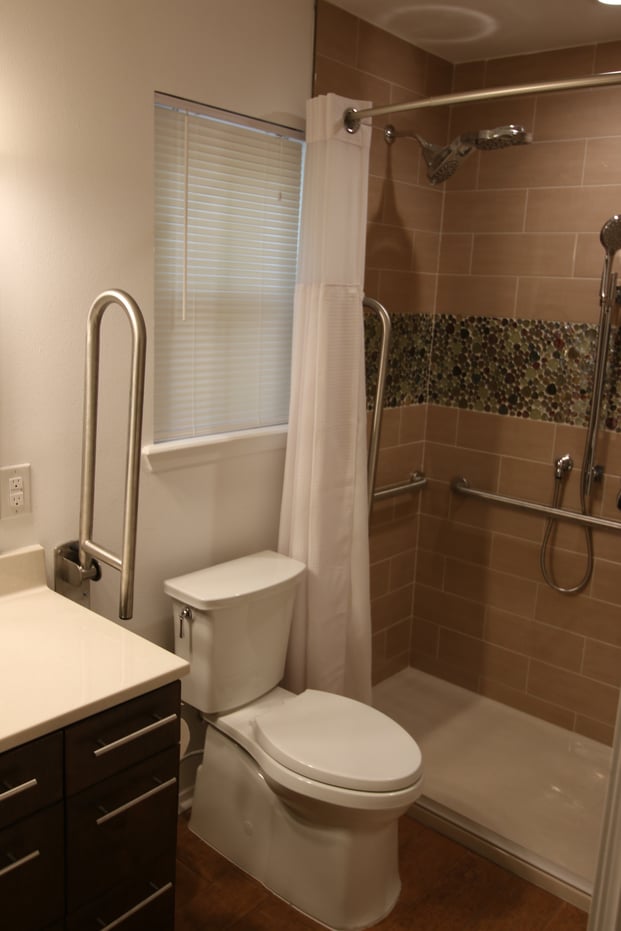
When mobility becomes an issue for any homeowner, regardless of age, the question arises concerning physically moving to a different home with a bath that is more accessible or making the existing home modifications which will meet the need of the new life changes.Solving aging in place issues will soon become the number one challenge concerning the present obsolete housing inventory in our country. Our present day obsolete homes now inhabited by the baby boomer generation will slowly and increasingly raise their outdated and obsolete ugly heads and expose their true lack of kitchen or bathroom accessibility to those very people inhabiting them. The situation will only become ever more expanding in time. When these homes were previously purchased, they represented an absolute castle in the world of their owners in which to prepare for a day and they also acted as a retreat from life's tough interactions. They housed our families, our memories, and our stuff. They represented a place where we could be ourselves. Our homes have always been exempt from any and all of the accessibility regulations that have been put in place since 1968 when our Viet Nam veterans were returning home. The new evolving concept known as Universal Design and specialized handicap remodeling contractors for home remodeling is catching on nationwide and has been for several years as a sign of the times. Universal design techniques used in building makes a home more accessible to all regardless of their mobility or adaptive abilities.
Many people find themselves needing accessible homes for themselves or family members. There are approximately 30 million Americans using wheelchairs and the number of people who need accessible homes will continue to increase as disabled and aging people are finding more ways to remain living in their homes. One important way to increase independent living is making a home accessible to an individual’s personal needs. Home modifications making homes wheelchair accessible can increase safety, accessibility, and independence for people who want to live independently.

Falls and slips are among the most common causes of injury to senior or elderly people and for those with a disability. Smooth surfaces in combination with wet areas make the bathroom one of the most dangerous areas within the home. It is of paramount importance that the bathroom be updated providing safety for any person with limited mobility or the elderly. Grab bar installation will greatly improve safety and usability of the bathroom.
If the residence is fairly new and uses universal design techniques or the geographic area uses accessible housing standards, the walls in the tub area and the walls behind and next to the toilet should have extra blocking. Blocking is a structural reinforcement within a wall that allows a grab bar to be attached securely to withstand a 250 pound force. Studs can also be used but may not be located in the most desirable location for the length of the grab bar being used. The purpose of a grab bar is to help support a person, and the grab bar must be able to support a person's weight until help arrives or the person can right themselves. A grab bar is both pulled and pushed against.The standard size for a grab bar is 1-1/4 to 1-1/2 inches in diameter and should be 1-1/2 inches away from the wall. With some new construction, blocking is placed in the walls such that grab bars can be installed easily at a later date when needed. If there is no blocking in the walls, it can be added later but the wall must be open up to expose the studs. The recommended type is 3/4 inch plywood, 6 to 12 inches wide and nailed into the studs or a 2 by 6 or 8 inch block nailed into the studs. Today, grab bars come in many metal finishes and decorative shapes. Contrasting colors are easier to see in an emergency. Grab bars with a slight milled in texture are easier to grip. The blocking should be the full length of the tub and at both ends. This allows grab bars to be installed anywhere in the area or in more than one place. Never install grab bars on an angle where wet hands can slip. Grab bars should exist on all sides of the shower and tub walls. At the toilet, the blocked areas should be behind the toilet and on at least one side. If there is no wall next to the toilet, an L-shaped grab bar can be installed by attaching the front end to the floor and the back to the wall behind the toilet. All grab bars should be installed at the universal height of 34-36 inches above the finished floor. Folding grab bars can be used when adjacent walls don't exist in a 24" reach distance for a seated person.

Once the demands of our built environment exceed their capacities we become excluded from a room or even the entire home. The building world must work in unison to be sure the entire living environment meets basic needs in addition to affordability and structural integrity for the consumer and home owner. This includes both the home and the components within the home being accessible to all inhabitants. Privacy, sense of belonging, sense of control, and the sense of safety and security make up the quality of life for any home and should be considered for any design. Universal Design is where we are headed out of necessity.
Tags:
age in place home design,
what does it mean to age in place,
universal designbuilding for the future,
residential general contractor Austin, Texas,
home accessibility help in Austin,
home remodeling for disabled in Austin Texas,
wheelchair accessible home remodeling in Austin,
universal design remodeling contractor,
universal principles of design,
applying principles of universal design in Austin,
remodeling for elders in Austin,
disability contractor in Austin,
special needs contractor in Austin,
disability and special needs contractor Austin,
senior home modifications in Austin,
home modifications for elderly in Austin,
bathrooms with disability access in Austin, Texas,
Austin disability contractors for special needs,
Austin handicap bathroom contractor,
handicap accessible remodeling,
barrier free remodeling,
handicap remodeling,
handicap accessible bathroom remodeling,
handicap accessible home renovations,
handicap accessible home modifications,
disability remodeling,
handicap accessible bathroom remodel,
Austin aging in place specialist,
handicap access bathroom remodel,
handicap accessible bathroom shower,
handicap bathroom remodel,
ADA compliant wheelchair accessible showers,
roll in shower design for wheelchair access,
disability access contractor,
accessible home remodeling for disabilities,
home modifications for Austin veterans,
veterans home remodeling in Austin, Texas,
veterans home accessibility help in Austin, Texas,
barrier free showers in Austin,
ADA compliant roll in showers,
handicap ADA roll in shower,
wheelchair accessible shower stalls,
roll in shower,
accessible bathroom design specifications,
wheelchair accessible toilets,
handicap accessible toilets,
ADA Compliant grab bars,
ADA compliant grab bar height




























